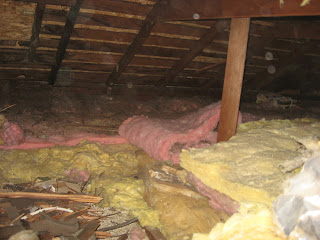This temporary access was then cut through a low wall, and an excessive dozen vermiculite samples were collected in a mapped circuit of the attic. An area of 300 sf was found to have vermiculite depth 2" or less, and repair needs via a good drop-down ladder were found. Four samples were tested, and all were found to have less than 1% asbestos content.
To me, the 13" by 14" opening was sufficient for many further entries. It passed the 55-gallon drum liners that would collect the vermiculite and the usual roof debris. For any other worker, and for disposal, the planned ladder must be completed.
Please find several posts about 55-gallon drum liners.
As generally mentioned in this blog, Label Vermiculite .
Distributing or Hauling-Out Loose-Fill Insulation (includes ordering info)
55-Gallon Drum Liners, Again
Know these collapsible containers 30-mil thickness stand upright for loading. Nearly-full of vermiculite, the carry is a bearable forty pounds.
I of course do not work at any time without a suitable respirator.
The 14' span of 2x4 joists demands strengthening to tolerate any load in addition to the weight of shiplap and 1/4" drywall, and to allow a cut joist. I therefore must empty and clean the attic all the way across, and bridge out a minimum of interfering knob and tube wires.
My dual-filter Porter Cable 7812 vacuum has 99.85% filtration efficiency. It was resident outside the attic, until the ladder was in. Then I mostly worked with the ladder door closed behind me. I will edit this post to address things I did wrong.
Jump ahead here, to a condition after debris has been carried down the new ladder. The floor is extremely rigid, far stronger than found, with framing in-effect 2x10 select fir. 9" strips of CDX plywood wall-to-wall are attached to the 14' found joists and to 13' 4" added 2x4's leveled to hold plywood flooring. Deck screws at 6" intervals make the attachment. The assembly locks a sag of nearly an inch at mid-span of the floor joists. At a stopped condition for electrical service, all floor area is again insulated, with R8 fiberglass batts minimum.
I like the disposal policy in metro Portland, Oregon, where vermiculite tested at under 1% asbestos, may be disposed as trash, at the Oregon City transfer station. Vermiculite at greater than 1% asbestos would have been handled by a licensed abatement contractor, with disposal at the adjacent hazardous-materials facility.
200 gallons.
A trash hauler might be arm-twisted to accept this. I doubt it. Placing it in a drop-box dumpster would have to be approved, and might raise concern and refusal in further handling.
Thoroughly wetting the vermiculite will reduce concerns on the further path to an Eastern Oregon landfill. I understand that vermiculite holds water. Much effort is needed to dry wet test specimens.
I will feel less bad about my contribution, than should disposers of bulk, where there has been no step of recycling.
I ask that Portland's Metro add receiving requirements for vermiculite, as "special waste." The application for this costs $25, and I think that is fair. Dock workers should not accept my unsubstantiated word, and they do not have means of recording permissions. In this case, special waste might have special handling: the wet-down requirement.
I was prepared here with a blank application, but wanted to experience the permitted procedure, and was happy to save my customer the $25.
Back at the job site, others will appreciate the wonderful Calvert attic ladder. It is Model 1028, with 28" x 48" rough opening. It includes my first try of the optional insulation panel to R14.
Little toe room remains when upon steps over the door. That is where good toe engagement is most needed. Assess lost safety, vs. achieved savings in heat transmission through the door. Consider Insulation Math. The door area for heat transmission is 28" x 48", 1344 sq in, 9.3 sq ft. Say claimed R14 is a system number including convection resistances, and without the cover, system has R7. The savings differential for Portland, OR is 2.4 *9.3 * (1/7 - 1/14) = $1.59 per year, and the savings will continue indefinitely. This beats the achievement of a foolish ladder cover. On the other hand, the $1.59 savings are probably foolish where offset by danger of falling with the lesser toe space.
At August 2015, add to this a photo album link . See what bags of bad vermiculite looked like, before they were dumped in an attic. I wonder, was all vermiculite, whether testing OK for disposal, or not, sold in these same bags, in, say, the Portland, Oregon market? What would a bag of good vermiculite have looked like, in your community? In my community, I think bad old Zonolite from Libby, Montana, often tests as good for disposal, and should. I am so happy where I can get it out of someone's house affordably. Is good vermiculite, not from Libby, MT, always good?
Please find all posts at this blog, about vermiculite removal, by Label search:
Vermiculite










